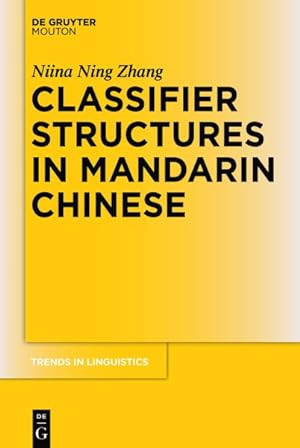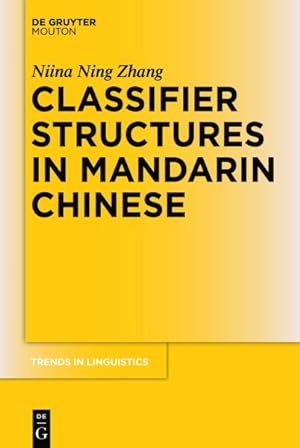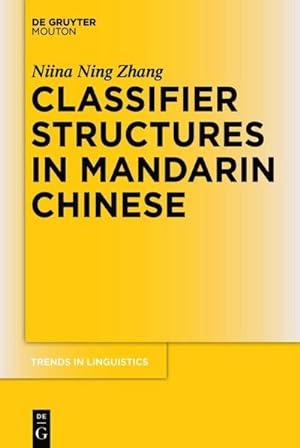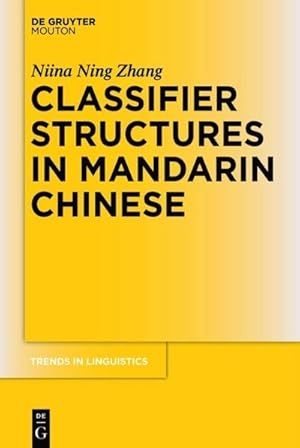Classifier Structures Mandarin Chinese by Zhang Niina (32 results)
Search filters
Product Type
- All Product Types
- Books (32)
- Magazines & Periodicals (No further results match this refinement)
- Comics (No further results match this refinement)
- Sheet Music (No further results match this refinement)
- Art, Prints & Posters (No further results match this refinement)
- Photographs (No further results match this refinement)
- Maps (No further results match this refinement)
- Manuscripts & Paper Collectibles (No further results match this refinement)
Condition Learn more
- New (30)
- As New, Fine or Near Fine (2)
- Very Good or Good (No further results match this refinement)
- Fair or Poor (No further results match this refinement)
- As Described (No further results match this refinement)
Binding
Collectible Attributes
- First Edition (2)
- Signed (No further results match this refinement)
- Dust Jacket (No further results match this refinement)
- Seller-Supplied Images (18)
- Not Print on Demand (23)
Language (1)
Free Shipping
Seller Location
Seller Rating
-
US$ 15.41
Convert currencyUS$ 2.64 shipping within U.S.A.Quantity: Over 20 available
Add to basketCondition: New.
-
Classifier Structures in Mandarin Chinese (Paperback or Softback)
Published by Walter de Gruyter 6/20/2016, 2016
ISBN 10: 3110488051 ISBN 13: 9783110488050
Language: English
Seller: BargainBookStores, Grand Rapids, MI, U.S.A.
Paperback or Softback. Condition: New. Classifier Structures in Mandarin Chinese. Book.
-
Classifier Structures in Mandarin Chinese (Trends in Linguistics. Studies and Monographs [TiLSM], 263)
Seller: Lucky's Textbooks, Dallas, TX, U.S.A.
US$ 16.41
Convert currencyUS$ 3.99 shipping within U.S.A.Quantity: Over 20 available
Add to basketCondition: New.
-
US$ 17.84
Convert currencyUS$ 2.64 shipping within U.S.A.Quantity: Over 20 available
Add to basketCondition: As New. Unread book in perfect condition.
-
US$ 32.85
Convert currencyFree shipping from United Kingdom to U.S.A.Quantity: Over 20 available
Add to basketPaperback. Condition: New. This monograph addresses fundamental syntactic issues of classifier constructions, based on a thorough study of a typical classifier language, Mandarin Chinese. It shows that the contrast between count and mass is not binary. Instead, there are two independently attested features: Numerability, the ability of a noun to combine with a numeral directly, and Delimitability, the ability of a noun to be modified by a delimitive modifier, such as size, shape, or boundary modifier. Although all nouns in Chinese are non-count nouns, there is still a mass/non-mass contrast, with mass nouns selected by individuating classifiers and non-mass nouns selected by individual classifiers. Some languages have the counterparts of Chinese individuating classifiers only, some languages have the counterparts of Chinese individual classifiers only, and some other languages have no counterpart of either individual or individuating classifiers of Chinese. The book also reports that unit plurality can be expressed by reduplicative classifiers in the language. Moreover, for the constituency of a numeral expression, an individual, individuating, or kind classifier combines with the noun first and then the numeral is integrated; but a partitive or collective classifier, like a measure word, combines with the numeral first, before the noun is integrated into the whole nominal structure. Furthermore, the book identifies the syntactic positions of various uses of classifiers in the language. A classifier is at a functional head position that has a dependency with a numeral, or a position that has a dependency with a generic or existential quantifier, or a position that represents the singular-plural contrast, or a position that licenses a delimitive modifier when the classifier occurs in a compound.
-
Classifier Structures in Mandarin Chinese (Trends in Linguistics. Studies and Monographs [TiLSM], 263)
Seller: Ria Christie Collections, Uxbridge, United Kingdom
US$ 28.00
Convert currencyUS$ 15.96 shipping from United Kingdom to U.S.A.Quantity: Over 20 available
Add to basketCondition: New. In.
-
US$ 42.98
Convert currencyUS$ 10.50 shipping within U.S.A.Quantity: Over 20 available
Add to basketCondition: New. 2016. Paperback. . . . . . Books ship from the US and Ireland.
-
US$ 27.03
Convert currencyUS$ 33.30 shipping from United Kingdom to U.S.A.Quantity: 2 available
Add to basketPaperback. Condition: Brand New. reprint edition. 332 pages. 6.10x9.05x0.91 inches. In Stock.
-
Classifier Structures in Mandarin Chinese
Seller: Kennys Bookshop and Art Galleries Ltd., Galway, GY, Ireland
US$ 51.70
Convert currencyUS$ 12.18 shipping from Ireland to U.S.A.Quantity: Over 20 available
Add to basketCondition: New. 2016. Paperback. . . . . .
-
US$ 24.87
Convert currencyUS$ 50.00 shipping within U.S.A.Quantity: Over 20 available
Add to basketPaperback. Condition: New. This monograph addresses fundamental syntactic issues of classifier constructions, based on a thorough study of a typical classifier language, Mandarin Chinese. It shows that the contrast between count and mass is not binary. Instead, there are two independently attested features: Numerability, the ability of a noun to combine with a numeral directly, and Delimitability, the ability of a noun to be modified by a delimitive modifier, such as size, shape, or boundary modifier. Although all nouns in Chinese are non-count nouns, there is still a mass/non-mass contrast, with mass nouns selected by individuating classifiers and non-mass nouns selected by individual classifiers. Some languages have the counterparts of Chinese individuating classifiers only, some languages have the counterparts of Chinese individual classifiers only, and some other languages have no counterpart of either individual or individuating classifiers of Chinese. The book also reports that unit plurality can be expressed by reduplicative classifiers in the language. Moreover, for the constituency of a numeral expression, an individual, individuating, or kind classifier combines with the noun first and then the numeral is integrated; but a partitive or collective classifier, like a measure word, combines with the numeral first, before the noun is integrated into the whole nominal structure. Furthermore, the book identifies the syntactic positions of various uses of classifiers in the language. A classifier is at a functional head position that has a dependency with a numeral, or a position that has a dependency with a generic or existential quantifier, or a position that represents the singular-plural contrast, or a position that licenses a delimitive modifier when the classifier occurs in a compound.
-
Classifier Structures in Mandarin Chinese
Published by De Gruyter Mouton, De Gruyter Jun 2016, 2016
ISBN 10: 3110488051 ISBN 13: 9783110488050
Language: English
Seller: buchversandmimpf2000, Emtmannsberg, BAYE, Germany
US$ 23.84
Convert currencyUS$ 69.62 shipping from Germany to U.S.A.Quantity: 2 available
Add to basketTaschenbuch. Condition: Neu. Neuware -This monograph addresses fundamental syntactic issues of classifier constructions, based on a thorough study of a typical classifier language, Mandarin Chinese. It shows that the contrast between count and mass is not binary. Instead, there are two independently attested features: Numerability, the ability of a noun to combine with a numeral directly, and Delimitability, the ability of a noun to be modified by a delimitive modifier, such as size, shape, or boundary modifier. Although all nouns in Chinese are non-count nouns, there is still a mass/non-mass contrast, with mass nouns selected by individuating classifiers and non-mass nouns selected by individual classifiers. Some languages have the counterparts of Chinese individuating classifiers only, some languages have the counterparts of Chinese individual classifiers only, and some other languages have no counterpart of either individual or individuating classifiers of Chinese. The book also reports that unit plurality can be expressed by reduplicative classifiers in the language. Moreover, for the constituency of a numeral expression, an individual, individuating, or kind classifier combines with the noun first and then the numeral is integrated; but a partitive or collective classifier, like a measure word, combines with the numeral first, before the noun is integrated into the whole nominal structure. Furthermore, the book identifies the syntactic positions of various uses of classifiers in the language. A classifier is at a functional head position that has a dependency with a numeral, or a position that has a dependency with a generic or existential quantifier, or a position that represents the singular-plural contrast, or a position that licenses a delimitive modifier when the classifier occurs in a compound.Walter de Gruyter GmbH, Genthiner Strasse 13, 10785 Berlin 332 pp. Englisch.
-
US$ 23.84
Convert currencyUS$ 78.22 shipping from Germany to U.S.A.Quantity: 1 available
Add to basketTaschenbuch. Condition: Neu. Druck auf Anfrage Neuware - Printed after ordering - This monograph addresses fundamental syntactic issues of classifier constructions, based on a thorough study of a typical classifier language, Mandarin Chinese. It shows that the contrast between count and mass is not binary. Instead, there are two independently attested features: Numerability, the ability of a noun to combine with a numeral directly, and Delimitability, the ability of a noun to be modified by a delimitive modifier, such as size, shape, or boundary modifier. Although all nouns in Chinese are non-count nouns, there is still a mass/non-mass contrast, with mass nouns selected by individuating classifiers and non-mass nouns selected by individual classifiers. Some languages have the counterparts of Chinese individuating classifiers only, some languages have the counterparts of Chinese individual classifiers only, and some other languages have no counterpart of either individual or individuating classifiers of Chinese. The book also reports that unit plurality can be expressed by reduplicative classifiers in the language. Moreover, for the constituency of a numeral expression, an individual, individuating, or kind classifier combines with the noun first and then the numeral is integrated; but a partitive or collective classifier, like a measure word, combines with the numeral first, before the noun is integrated into the whole nominal structure. Furthermore, the book identifies the syntactic positions of various uses of classifiers in the language. A classifier is at a functional head position that has a dependency with a numeral, or a position that has a dependency with a generic or existential quantifier, or a position that represents the singular-plural contrast, or a position that licenses a delimitive modifier when the classifier occurs in a compound.
-
US$ 30.33
Convert currencyUS$ 86.59 shipping from United Kingdom to U.S.A.Quantity: Over 20 available
Add to basketPaperback. Condition: New. This monograph addresses fundamental syntactic issues of classifier constructions, based on a thorough study of a typical classifier language, Mandarin Chinese. It shows that the contrast between count and mass is not binary. Instead, there are two independently attested features: Numerability, the ability of a noun to combine with a numeral directly, and Delimitability, the ability of a noun to be modified by a delimitive modifier, such as size, shape, or boundary modifier. Although all nouns in Chinese are non-count nouns, there is still a mass/non-mass contrast, with mass nouns selected by individuating classifiers and non-mass nouns selected by individual classifiers. Some languages have the counterparts of Chinese individuating classifiers only, some languages have the counterparts of Chinese individual classifiers only, and some other languages have no counterpart of either individual or individuating classifiers of Chinese. The book also reports that unit plurality can be expressed by reduplicative classifiers in the language. Moreover, for the constituency of a numeral expression, an individual, individuating, or kind classifier combines with the noun first and then the numeral is integrated; but a partitive or collective classifier, like a measure word, combines with the numeral first, before the noun is integrated into the whole nominal structure. Furthermore, the book identifies the syntactic positions of various uses of classifiers in the language. A classifier is at a functional head position that has a dependency with a numeral, or a position that has a dependency with a generic or existential quantifier, or a position that represents the singular-plural contrast, or a position that licenses a delimitive modifier when the classifier occurs in a compound.
-
Classifier Structures in Mandarin Chinese
Seller: PBShop.store US, Wood Dale, IL, U.S.A.
PAP. Condition: New. New Book. Shipped from UK. THIS BOOK IS PRINTED ON DEMAND. Established seller since 2000.
-
Classifier Structures in Mandarin Chinese (Trends in Linguistics. Studies and Monographs [TiLSM], 263)
Seller: Ria Christie Collections, Uxbridge, United Kingdom
US$ 199.84
Convert currencyUS$ 15.96 shipping from United Kingdom to U.S.A.Quantity: Over 20 available
Add to basketCondition: New. In.
-
US$ 221.28
Convert currencyUS$ 2.64 shipping within U.S.A.Quantity: Over 20 available
Add to basketCondition: New.
-
Classifier Structures in Mandarin Chinese (Trends in Linguistics. Studies and Monographs [TiLSM], 263)
Seller: Lucky's Textbooks, Dallas, TX, U.S.A.
US$ 219.94
Convert currencyUS$ 3.99 shipping within U.S.A.Quantity: Over 20 available
Add to basketCondition: New.
-
Hardback. Condition: New. 1st. This monograph addresses fundamental syntactic issues of classifier constructions, based on a thorough study of a typical classifier language, Mandarin Chinese. It shows that the contrast between count and mass is not binary. Instead, there are two independently attested features: Numerability, the ability of a noun to combine with a numeral directly, and Delimitability, the ability of a noun to be modified by a delimitive modifier, such as size, shape, or boundary modifier. Although all nouns in Chinese are non-count nouns, there is still a mass/non-mass contrast, with mass nouns selected by individuating classifiers and non-mass nouns selected by individual classifiers. Some languages have the counterparts of Chinese individuating classifiers only, some languages have the counterparts of Chinese individual classifiers only, and some other languages have no counterpart of either individual or individuating classifiers of Chinese. The book also reports that unit plurality can be expressed by reduplicative classifiers in the language. Moreover, for the constituency of a numeral expression, an individual, individuating, or kind classifier combines with the noun first and then the numeral is integrated; but a partitive or collective classifier, like a measure word, combines with the numeral first, before the noun is integrated into the whole nominal structure. Furthermore, the book identifies the syntactic positions of various uses of classifiers in the language. A classifier is at a functional head position that has a dependency with a numeral, or a position that has a dependency with a generic or existential quantifier, or a position that represents the singular-plural contrast, or a position that licenses a delimitive modifier when the classifier occurs in a compound.
-
US$ 258.56
Convert currencyUS$ 2.64 shipping within U.S.A.Quantity: Over 20 available
Add to basketCondition: As New. Unread book in perfect condition.
-
US$ 191.17
Convert currencyUS$ 73.39 shipping from Germany to U.S.A.Quantity: 1 available
Add to basketBuch. Condition: Neu. Druck auf Anfrage Neuware - Printed after ordering - This monograph addresses fundamental syntactic issues of classifier constructions, based on a thorough study of a typical classifier language, Mandarin Chinese. It shows that the contrast between count and mass is not binary. Instead, there are two independently attested features: Numerability, the ability of a noun to combine with a numeral directly, and Delimitability, the ability of a noun to be modified by a delimitive modifier, such as size, shape, or boundary modifier. Although all nouns in Chinese are non-count nouns, there is still a mass/non-mass contrast, with mass nouns selected by individuating classifiers and non-mass nouns selected by individual classifiers. Some languages have the counterparts of Chinese individuating classifiers only, some languages have the counterparts of Chinese individual classifiers only, and some other languages have no counterpart of either individual or individuating classifiers of Chinese. The book also reports that unit plurality can be expressed by reduplicative classifiers in the language. Moreover, for the constituency of a numeral expression, an individual, individuating, or kind classifier combines with the noun first and then the numeral is integrated; but a partitive or collective classifier, like a measure word, combines with the numeral first, before the noun is integrated into the whole nominal structure. Furthermore, the book identifies the syntactic positions of various uses of classifiers in the language. A classifier is at a functional head position that has a dependency with a numeral, or a position that has a dependency with a generic or existential quantifier, or a position that represents the singular-plural contrast, or a position that licenses a delimitive modifier when the classifier occurs in a compound.
-
Classifier Structures in Mandarin Chinese
Seller: Kennys Bookshop and Art Galleries Ltd., Galway, GY, Ireland
US$ 283.85
Convert currencyUS$ 12.18 shipping from Ireland to U.S.A.Quantity: Over 20 available
Add to basketCondition: New. 2013. Hardcover. . . . . .
-
Classifier Structures in Mandarin Chinese (Trends in Linguistics. Studies and Monographs [Tilsm])
Seller: Revaluation Books, Exeter, United Kingdom
US$ 276.88
Convert currencyUS$ 33.30 shipping from United Kingdom to U.S.A.Quantity: 2 available
Add to basketHardcover. Condition: Brand New. 331 pages. 9.29x6.30x0.94 inches. In Stock.
-
Classifier Structures in Mandarin Chinese
Seller: Rarewaves USA United, OSWEGO, IL, U.S.A.
First Edition
US$ 269.77
Convert currencyUS$ 50.00 shipping within U.S.A.Quantity: Over 20 available
Add to basketHardback. Condition: New. 1st. This monograph addresses fundamental syntactic issues of classifier constructions, based on a thorough study of a typical classifier language, Mandarin Chinese. It shows that the contrast between count and mass is not binary. Instead, there are two independently attested features: Numerability, the ability of a noun to combine with a numeral directly, and Delimitability, the ability of a noun to be modified by a delimitive modifier, such as size, shape, or boundary modifier. Although all nouns in Chinese are non-count nouns, there is still a mass/non-mass contrast, with mass nouns selected by individuating classifiers and non-mass nouns selected by individual classifiers. Some languages have the counterparts of Chinese individuating classifiers only, some languages have the counterparts of Chinese individual classifiers only, and some other languages have no counterpart of either individual or individuating classifiers of Chinese. The book also reports that unit plurality can be expressed by reduplicative classifiers in the language. Moreover, for the constituency of a numeral expression, an individual, individuating, or kind classifier combines with the noun first and then the numeral is integrated; but a partitive or collective classifier, like a measure word, combines with the numeral first, before the noun is integrated into the whole nominal structure. Furthermore, the book identifies the syntactic positions of various uses of classifiers in the language. A classifier is at a functional head position that has a dependency with a numeral, or a position that has a dependency with a generic or existential quantifier, or a position that represents the singular-plural contrast, or a position that licenses a delimitive modifier when the classifier occurs in a compound.
-
US$ 337.33
Convert currencyUS$ 10.50 shipping within U.S.A.Quantity: Over 20 available
Add to basketCondition: New. 2013. Hardcover. . . . . . Books ship from the US and Ireland.
-
Classifier Structures in Mandarin Chinese
Seller: PBShop.store UK, Fairford, GLOS, United Kingdom
US$ 25.71
Convert currencyUS$ 6.69 shipping from United Kingdom to U.S.A.Quantity: 15 available
Add to basketPAP. Condition: New. New Book. Delivered from our UK warehouse in 4 to 14 business days. THIS BOOK IS PRINTED ON DEMAND. Established seller since 2000.
-
Classifier Structures in Mandarin Chinese
Published by De Gruyter Mouton Jun 2016, 2016
ISBN 10: 3110488051 ISBN 13: 9783110488050
Language: English
Seller: BuchWeltWeit Ludwig Meier e.K., Bergisch Gladbach, Germany
US$ 23.84
Convert currencyUS$ 26.69 shipping from Germany to U.S.A.Quantity: 2 available
Add to basketTaschenbuch. Condition: Neu. This item is printed on demand - it takes 3-4 days longer - Neuware -This monograph addresses fundamental syntactic issues of classifier constructions, based on a thorough study of a typical classifier language, Mandarin Chinese. It shows that the contrast between count and mass is not binary. Instead, there are two independently attested features: Numerability, the ability of a noun to combine with a numeral directly, and Delimitability, the ability of a noun to be modified by a delimitive modifier, such as size, shape, or boundary modifier. Although all nouns in Chinese are non-count nouns, there is still a mass/non-mass contrast, with mass nouns selected by individuating classifiers and non-mass nouns selected by individual classifiers. Some languages have the counterparts of Chinese individuating classifiers only, some languages have the counterparts of Chinese individual classifiers only, and some other languages have no counterpart of either individual or individuating classifiers of Chinese. The book also reports that unit plurality can be expressed by reduplicative classifiers in the language. Moreover, for the constituency of a numeral expression, an individual, individuating, or kind classifier combines with the noun first and then the numeral is integrated; but a partitive or collective classifier, like a measure word, combines with the numeral first, before the noun is integrated into the whole nominal structure. Furthermore, the book identifies the syntactic positions of various uses of classifiers in the language. A classifier is at a functional head position that has a dependency with a numeral, or a position that has a dependency with a generic or existential quantifier, or a position that represents the singular-plural contrast, or a position that licenses a delimitive modifier when the classifier occurs in a compound. 332 pp. Englisch.
-
Classifier Structures in Mandarin Chinese
Seller: moluna, Greven, Germany
US$ 24.40
Convert currencyUS$ 56.85 shipping from Germany to U.S.A.Quantity: Over 20 available
Add to basketCondition: New. Dieser Artikel ist ein Print on Demand Artikel und wird nach Ihrer Bestellung fuer Sie gedruckt. Niina Ning Zhang, Nat.
-
Classifier Structures in Mandarin Chinese
Seller: PBShop.store UK, Fairford, GLOS, United Kingdom
US$ 209.01
Convert currencyUS$ 6.69 shipping from United Kingdom to U.S.A.Quantity: Over 20 available
Add to basketHRD. Condition: New. New Book. Delivered from our UK warehouse in 4 to 14 business days. THIS BOOK IS PRINTED ON DEMAND. Established seller since 2000.
-
Classifier Structures in Mandarin Chinese
Seller: PBShop.store US, Wood Dale, IL, U.S.A.
HRD. Condition: New. New Book. Shipped from UK. THIS BOOK IS PRINTED ON DEMAND. Established seller since 2000.
-
Classifier Structures in Mandarin Chinese
Published by De Gruyter Mouton, De Gruyter Mouton Mai 2013, 2013
ISBN 10: 3110303744 ISBN 13: 9783110303742
Language: English
Seller: BuchWeltWeit Ludwig Meier e.K., Bergisch Gladbach, Germany
US$ 191.17
Convert currencyUS$ 26.69 shipping from Germany to U.S.A.Quantity: 2 available
Add to basketBuch. Condition: Neu. This item is printed on demand - it takes 3-4 days longer - Neuware -This monograph addresses fundamental syntactic issues of classifier constructions, based on a thorough study of a typical classifier language, Mandarin Chinese. It shows that the contrast between count and mass is not binary. Instead, there are two independently attested features: Numerability, the ability of a noun to combine with a numeral directly, and Delimitability, the ability of a noun to be modified by a delimitive modifier, such as size, shape, or boundary modifier. Although all nouns in Chinese are non-count nouns, there is still a mass/non-mass contrast, with mass nouns selected by individuating classifiers and non-mass nouns selected by individual classifiers. Some languages have the counterparts of Chinese individuating classifiers only, some languages have the counterparts of Chinese individual classifiers only, and some other languages have no counterpart of either individual or individuating classifiers of Chinese. The book also reports that unit plurality can be expressed by reduplicative classifiers in the language. Moreover, for the constituency of a numeral expression, an individual, individuating, or kind classifier combines with the noun first and then the numeral is integrated; but a partitive or collective classifier, like a measure word, combines with the numeral first, before the noun is integrated into the whole nominal structure. Furthermore, the book identifies the syntactic positions of various uses of classifiers in the language. A classifier is at a functional head position that has a dependency with a numeral, or a position that has a dependency with a generic or existential quantifier, or a position that represents the singular-plural contrast, or a position that licenses a delimitive modifier when the classifier occurs in a compound. 332 pp. Englisch.




![Stock image for Classifier Structures in Mandarin Chinese (Trends in Linguistics. Studies and Monographs [TiLSM], 263) for sale by Lucky's Textbooks](https://pictures.abebooks.com/isbn/9783110488050-us-300.jpg)






![Stock image for Classifier Structures in Mandarin Chinese (Trends in Linguistics. Studies and Monographs [TiLSM], 263) for sale by Ria Christie Collections](https://pictures.abebooks.com/isbn/9783110303742-us-300.jpg)







